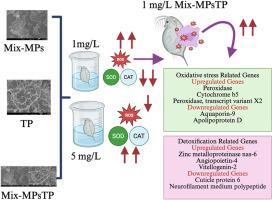Combined Effect of Microplastics and Tire Particles on Daphnia magna: Insights from Physiological and Transcriptomic Responses
IF 7.3
2区 环境科学与生态学
Q1 ENVIRONMENTAL SCIENCES
引用次数: 0
Abstract
Microplastics (MPs) and tire particles (TP) are ubiquitous in freshwater ecosystems, raising growing concerns about their ecological impacts. However, limited studies have explored their combined effects. This study investigates the physiological and transcriptomic responses of Daphnia magna to environmentally relevant concentrations (1 and 5 mg/L) of MPs, TP, and their mixture (Mix-MPsTP). Microscopic analyses confirmed particle ingestion and accumulation in the gut, with greater retention observed at the lower concentration, suggesting a non-linear dose-response possibly driven by particle aggregation or avoidance behavior. Oxidative stress biomarkers revealed significant elevation in reactive oxygen species (ROS) and superoxide dismutase (SOD) activity, particularly in the Mix-MPsTP 1 mg/L group, while catalase (CAT) activity was suppressed at higher doses. Despite ROS induction, malondialdehyde (MDA) levels remained unchanged, indicating successful mitigation of lipid peroxidation. Transcriptomic data aligned with physiological findings, showing upregulation of antioxidant-related genes such as peroxidases, cytochrome b5, and endochitinase A, along with metabolic genes like vitellogenin-2 and C-reactive protein. While glycogen levels were significantly affected, protein content remained unchanged, implying preserved metabolic stability under short-term stress. Importantly, this study fills a critical knowledge gap, as no prior research has comprehensively examined the mixture effects of different MPs, TP, and Mix-MPsTP on aquatic organisms. The results highlight the complexity of pollutant interactions and underscore the need for mixture-based assessments in ecotoxicological research and risk management strategies.

微塑料和轮胎颗粒对大水蚤的综合影响:来自生理和转录组反应的见解
微塑料(MPs)和轮胎颗粒(TP)在淡水生态系统中无处不在,引起了人们对其生态影响的日益关注。然而,有限的研究探索了它们的综合效应。本研究研究了大水蚤对环境相关浓度(1和5mg /L) MPs、TP及其混合物(Mix-MPsTP)的生理和转录组反应。显微镜分析证实了颗粒在肠道中的摄入和积累,在较低浓度下观察到更大的滞留,表明可能由颗粒聚集或回避行为驱动的非线性剂量反应。氧化应激生物标志物显示活性氧(ROS)和超氧化物歧化酶(SOD)活性显著升高,特别是在Mix-MPsTP 1 mg/L组,而过氧化氢酶(CAT)活性在较高剂量下受到抑制。尽管有ROS诱导,丙二醛(MDA)水平保持不变,表明脂质过氧化的成功缓解。转录组学数据与生理结果一致,显示抗氧化相关基因(如过氧化物酶、细胞色素b5和内质酶A)以及代谢基因(如卵黄蛋白原-2和c反应蛋白)上调。虽然糖原水平受到显著影响,但蛋白质含量保持不变,这意味着在短期应激下保持了代谢稳定性。重要的是,这项研究填补了一个关键的知识空白,因为之前没有研究全面考察了不同MPs、TP和Mix-MPsTP对水生生物的混合效应。研究结果强调了污染物相互作用的复杂性,并强调了在生态毒理学研究和风险管理策略中进行基于混合物的评估的必要性。
本文章由计算机程序翻译,如有差异,请以英文原文为准。
求助全文
约1分钟内获得全文
求助全文
来源期刊

Environmental Pollution
环境科学-环境科学
CiteScore
16.00
自引率
6.70%
发文量
2082
审稿时长
2.9 months
期刊介绍:
Environmental Pollution is an international peer-reviewed journal that publishes high-quality research papers and review articles covering all aspects of environmental pollution and its impacts on ecosystems and human health.
Subject areas include, but are not limited to:
• Sources and occurrences of pollutants that are clearly defined and measured in environmental compartments, food and food-related items, and human bodies;
• Interlinks between contaminant exposure and biological, ecological, and human health effects, including those of climate change;
• Contaminants of emerging concerns (including but not limited to antibiotic resistant microorganisms or genes, microplastics/nanoplastics, electronic wastes, light, and noise) and/or their biological, ecological, or human health effects;
• Laboratory and field studies on the remediation/mitigation of environmental pollution via new techniques and with clear links to biological, ecological, or human health effects;
• Modeling of pollution processes, patterns, or trends that is of clear environmental and/or human health interest;
• New techniques that measure and examine environmental occurrences, transport, behavior, and effects of pollutants within the environment or the laboratory, provided that they can be clearly used to address problems within regional or global environmental compartments.
 求助内容:
求助内容: 应助结果提醒方式:
应助结果提醒方式:


